A Guide to Finer Living in Connecticut & abroad

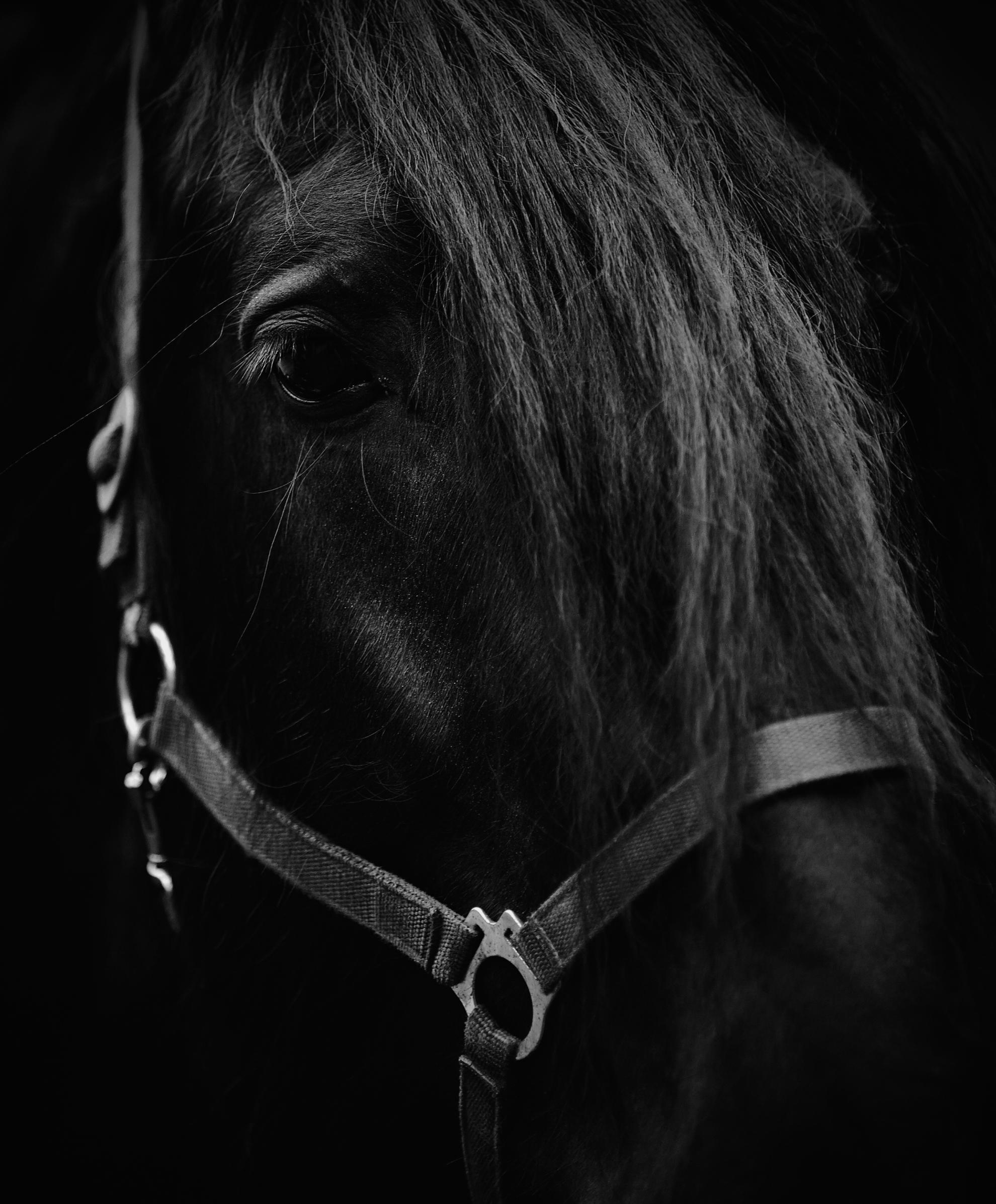
JANUARY 2023 Vol 18 Issue 204 inkct.com

As 2022 comes to a close, it’s important for everyone who is ready to retire—or close to retirement age—to take another look at their retirement plan. We can find the right strategies and opportunities to help high-net-worth families and individuals achieve all that is important going into retirement. Contact us today and ask about our second opinion service.

Investment and insurance products offered through RBC Wealth Management are not insured by the FDIC or any other federal government agency, are not deposits or other obligations of, or guaranteed by, a bank or any bank affiliate, and are subject to investment risks, including possible loss of the principal amount invested.



2022 RBC Wealth Management, a division of RBC Capital Markets, LLC, registered investment adviser and Member NYSE/FINRA/SIPC.






22-GN-03147 (12/22) Poulin Wealth Management Group 200 Glastonbury Boulevard, Suite
Glastonbury,
06033 (860)657-1757
©
103
CT
www.poulinwealth.com
your
We can help get
financial house in order

“I hope that in this year to come, you make mistakes. Because if you are making mistakes, then you are making new things, trying new things, learning, living, pushing yourself, changing yourself, changing your world. You're doing things you've never done before, and more importantly, you're doing something.” — Neil Gaiman

Eighteen years old. This magazine has taken eighteen years to get here. Ink launched it’s journey in 2005. If you think about what was going on then, it puts that distance into stark perspective. I remember quite well, selling a full-page cover insertion to one of the two major casinos while standing in my yard on a “Motorola Razor” phone. If you remember the phone, then you must also remember that there was no such thing as an iPad. Smart phones had yet to be developed and would debut within two years. That’s a different world. A little better now, and in many ways not worse then, and probably both reversed if you are one of those types who likes to keep score of the game. “We do find ourselves mucking about a bit more than we need too but that’s just my two cents.” Ok... back to the story. INK in many was not “created” as much as it was born. There was/is fertile soil here on the Connecticut shoreline and also the surrounding states. At the time of the magazines inception, I was still a transplant to the area. I saw the wealth of history, innovation, and talent that exists here through fresh eyes.This inspired me to share the stories that I was coming across. To put together a talented group of people and to assemble, on paper, the time and the place we occupy at the moment. I am extremely lucky to have each of my contributers and consider them all to be my friends as well. Many of them have been pitching story ideas for over a decade. Each one of our writers and photographers have brought stories to life in INK that are still as timely as the day they were written. That is not by accident either. Also, we need to emphasize the importance of our marketing representatives as well as all of our partners. Without even one of them, it could not happen. Thank you all, welcome to a new year!
 Jeffery Lilly founder / publisher
Jeffery Lilly founder / publisher
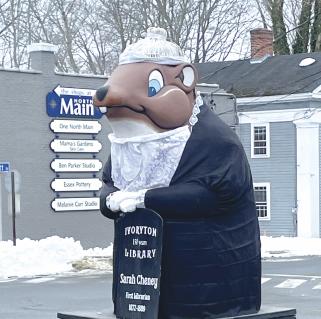
Rona Mann - editorial Carolina Marquez-Sterling - design Paul Partica - the cheesemonger Robert Rabine - editorial

Contact

us

Rona Mann - Greater Connecticut six07co@att.net - 401-539-7762



On the Cover: Portrait of Shadow / Photo by Elya Vatel

5 28 64
visit inkct.com JANUARY 2023 Vol. 18 Iss ue 204 Feature Stories
LLC
314 Flat Rock Place Unit
All content of INK Publications including but not limited to text, photos, graphics and layout are copyrighted by Inkct
without the permission of the publisher are prohibited. Inkct LLC is not responsible for images or graphics
advertisers which are not copyrighted or released for use in this publication
Advertising Contributors Departments Inkct
-
F125, Westbrook, CT 06498 - email: submissions@ink-pub.com - visit www.inkct.com
LLC. Reproductions
submitted for editorial or by
Ashley Alt - ask ashley Laurencia Ciprus - editorial Susan Cornell - editorial Caryn B. Davis - editorial/photography
Jeffery Lilly - Publisher 860.581.0026 Bob Houde - Advertising Director bob@inkct.com 860.303.6690
to
Richard Malinsky - Shoreline richard@inkct.com - 215.704.9273 our
receive
media kit with detailed marketing information.
Caryn Paradis Interiors Unique by Definition Professional by Performance
A
Fly Emily Mueller
10 20 32 40 48
28
64
Essex Ed Strikes Again A Hog Wild Holiday in Essex
Viking Ship Hand-built in Stony Creek Where Pigs
takes Good Care of Her Friends Mrs. Patricia Kelly Transforming Lives in Hoofbeats at the Ebony Horsewoman
Ask Ashley - New Year, Better You
The Cheesemonger - I forgot the name...
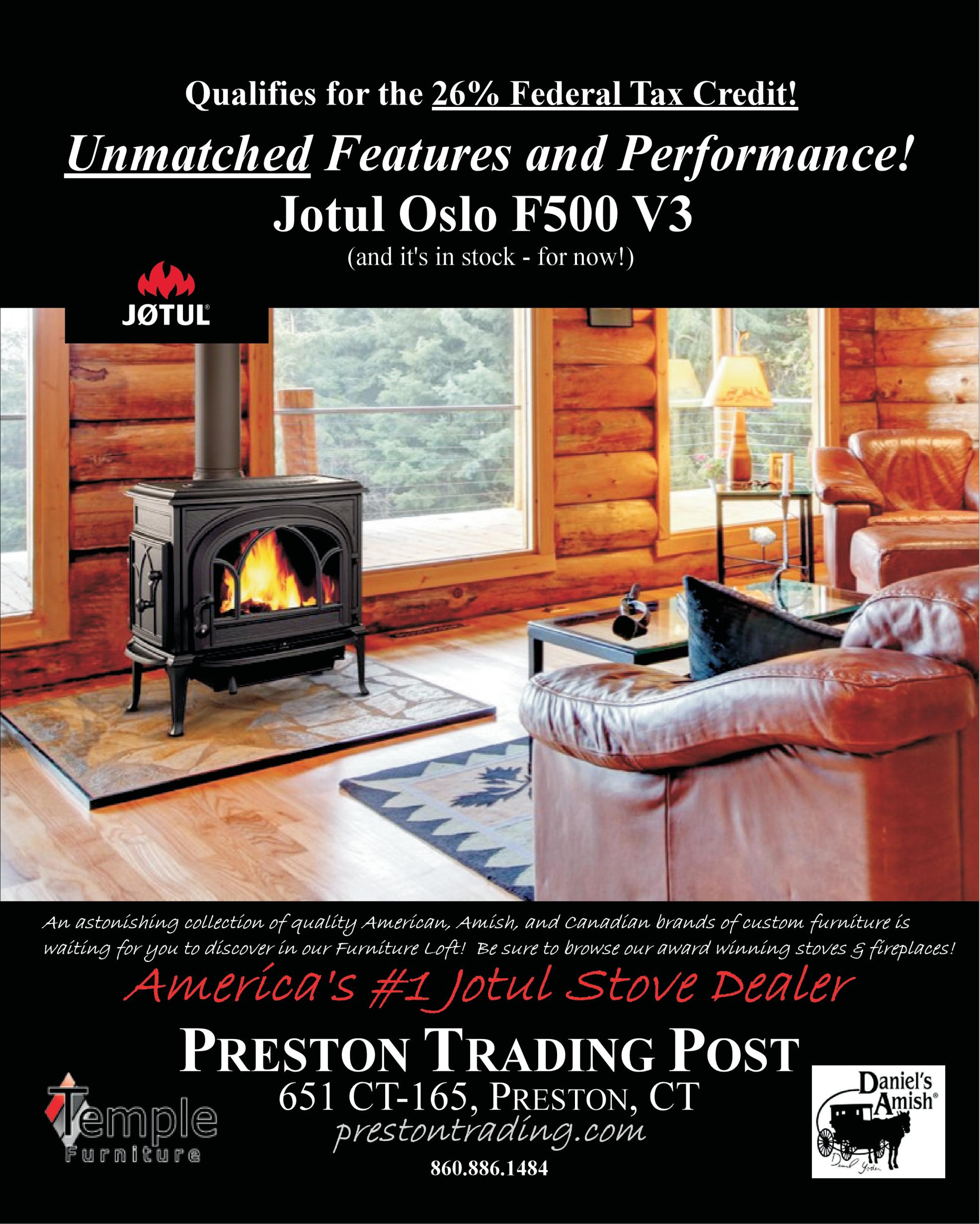

































































The Premier Resource t o the Connecticut Artisan FIRST I M Also C PRESSIO N ONGRATULATTIIONS , fe S – Annual Asso c eaturing new w E lecte d iate Artists Show & Artist Members Sale yWednesda Hours: ery ept Gall ec ng R 1 Openin January Ap by 5 –, 10 am ySunda – 5 pm or 4 p – 15, 2 , Januar y y 2023 ion, Sunda March – 2, 13 ry ppointment m Prese Art: Brian McClear, Justine, oil; Earl Grenville nting Sponsor Killeen, Lurking eti T or; Jessica T , watercol Te Tuurgoose, Happiness is a Ride on a Carousel, pastel; Debbi Goodman, Steel and Steam and Solitude, oil and acrylic; Garnet Wrigley, Pumpkin Pa www.LLyymeArtAssociation.org tch, Preston oil. Closing January 28, 2023 Inviting visitors young and old to enter into paintings brimming with animals, mystical figures and faraway places. Lyman Allyn ART MUSEUM 9 0 th Celebrating the power of art since 1932 625 Williams Street New London, CT lymanallyn.org Exit 83 off I-95 The Circle Game Pamela Zagarenski Second Star to the Right detail, acrylic, 15 x 25 inches. 9


10
Cogan Station, Pennsylvania.
It’s one of those towns no one’s ever heard of. Just in case you’re one of those folks, here are a few facts to get you informed. Its last census revealed a population of a mere 4600 folks, but it’s only 12 miles from the “big” city of Williamsport, famous for hosting the Little League World Series each year.
Cogan Station is known for...well, it’s the center of the gas industry for Lycoming County, there’s a popular restaurant called The Crippled Bear, and perhaps most important of all to the readers of Ink, renowned interior designer, Caryn Paradis grew up in Cogan Station. Happily for clients throughout New England and beyond, Caryn Paradis left Cogan Station early on and eventually settled in Connecticut where during the last 10 years she has carved out a reputation, a following, and an enviable referral list as a premier interior design firm, building an ever-growing and select group of satisfied clients. First, however, some clarification because before you meet the woman and her team, you have to understand exactly what it is they do.
Many people, when they hear the term “interior design,” believe it to be interchangeable with “interior decorating.” While interior decorating is what viewers see most often on home makeover programs or DIY projects on Pinterest, the operative word in interior design is “functional.” Interior design is at its most basic, the art and science of understanding people’s behavior in order to create functional spaces for them within a building. Interior decorating, on the other hand, is just that...decorating, adorning the space aesthetically. Interior designers may decorate to an extent, but interior decorators do not design. Interior designers are charged with improving the experiences of the people who inhabit the space they create, and that involves applying creative and technical solutions within a structure that are functional while also being attractive and beneficial.
 Shown above: Caryn Paradis NCIDQ, Kim Vickerman, Design Manager, Brunette-Haylee Cox, Interior Designer Not pictured, office manager, Bonnie Ludovico
Shown above: Caryn Paradis NCIDQ, Kim Vickerman, Design Manager, Brunette-Haylee Cox, Interior Designer Not pictured, office manager, Bonnie Ludovico
11
Photo by Jeffrey Lilly


12
Photos by Caryn B. Davis
That being said, Caryn Paradis uses both her right brain and left brain when working with clients. She is all at once scientific in her approach, yet she knows about color, texture, and aesthetics to add to the mix. Education? She’s had plenty. First, an Associate’s Degree in Graphic Design, then a Bachelor’s in Interior Design and Architecture, and finally an MBA in Arts Management. Paradis has had a strong background in knowing how to design, what to design, and what will work successfully, whether it be for commercial or residential space. She refers to what she does as “a sociology of space.”
The talent she possesses was also firmly bred in her DNA as Paradis freely admits with a laugh, “My Dad was a hippie who built a geodesic dome.” Hippies notwithstanding, in order to build this energy-saving polyhedron, one must have a whole lot of math knowledge in addition to architectural and design bones, and Caryn added that her mother was into art and design as well.
So, after a good deal of education, preparation, experience, and more than a little DNA, it was time to open Caryn Paradis Interior Design right in the center of Chester, a town to which Caryn was drawn and remains completely and totally enamored and invested in.


When you hear words like “form” and “function” when speaking of interior design, those words may sound cold and one-dimensional, but at Caryn Paradis Interior Design it is anything but. Paradis is passionate about her clients and wants to get to know them on every level before she attempts to design for them. It all begins with a formal process, the most important of which is the Pre-Design Phase, and that involves a rather extensive questionnaire wherein Caryn and her team find out as much as they can about their client: hobbies, likes and dislikes, favorite colors, how different scenarios make them feel, what they do for work, what they do to relax, do they entertain formally or casually, how many people in their family? Pets? Lifestyles?

13
Photos by Caryn B. Davis
From this starting point, and with the addition of much interpersonal communication, next, a Schematic is created. This is then followed by Design Development, Construction Documentation, and finally Construction Administration. Throughout this extensive process, Caryn works right along with her team in order to properly design, execute, construct, and finally put all the pieces together. Kim is the Design Coordinator working to keep every project on time and on budget; Haylee is yet another Interior Designer whose passion is creating the right spaces for each client; Bonnie as Company Administrator has her finger on the pulse of every job, coordinating and knowing exactly what is happening at all times; and Gracie is in charge of client hospitality and building security. Paradis serves as Project Manager, working closely both with the clients and all aspects of Construction Design.
The projects created and designed by Caryn Paradis Interior Design are primarily those that are residential and within the realm of the hospitality industry. As Caryn says, “They are people who understand and appreciate good design, not what’s ‘trendy.’ They are people who hire us for our expertise in what we do best, and above all, they give us their trust.” Right within the town of Chester, the Brushmill by the Waterfall historic restaurant located on a property that dates back to the 1800s, hired Caryn Paradis Interior Design for their complete renovation. Over a period of 18 months, Paradis designed and constructed the renovation while strictly preserving the history and integrity of the structure, keeping the original fireplace while adding a wine bar, new kitchen, expanded bar area, and an upstairs bathroom.
Paradis most enjoys “managing the experience” which is why every project taken on by Caryn Paradis Interior Design is, according to Caryn, “always a team effort.”


14
Above: The offices of Caryn Paradis Interior Design, pictured Kim Vickerman, Design Manager, Haylee Cox, Interior Designer. Photo by Jeffrey Lilly
Photo by Caryn B. Davis
Photo by Jeffery Lilly
Chester holds a very special place in Caryn’s heart. It’s not only where she hangs her license as an experienced designer, but where she hangs her hat and her heart.
She is proud to be a resident in town, raising her family in a place she considers very special and one to which she wants to continue giving her time and talent.

Although at this time, as we go to print, we are not at liberty to divulge her next project, but we can reveal that she is seriously looking into designing a hospitality venue that will both beautify and benefit the town of Chester, a town with 1000 less in population than Cogan Station!

Cogan Station. Yes, it’s one of those towns you’ve probably never heard of. But it’s a place where 50 years or so ago a couple of hippies built a geodesic dome, where they raised a daughter with the same interests in art, design, and architecture, and instilled in her that sometimes your best work is often done outside the box so long as you’ve got the education, the experience, and most importantly, the relationship with the people for whom you work. This, then, is Caryn Paradis, interior DESIGNER, not decorator! If you haven’t heard of her yet, you will.
That’s a promise. And one she’ll keep.
Caryn Paradis Interior Design is located at 3 North Main Street, Chester www.carynparadis.com (860) 322-4470
15
Photo by Caryn B. Davis


































































































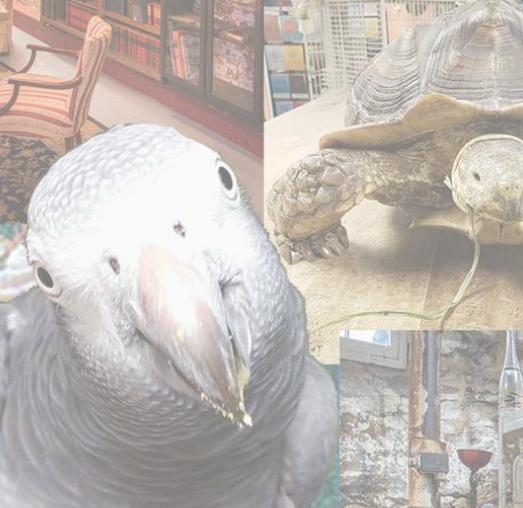










































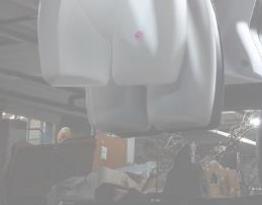








d k r s e n l eeply. Ref d atheBre a get café the nter d mid-wi ynast e t o The gif one just ve u ha yo w, in tasks xtraordinary x n an aso ay se holid nse ect... cur and drink warm Bu yourself. il ays spo , e. elf-car s of ve o gi t ft l gift e fa your of service the m ven so g ve u ha yo ha ul d . boo od a go with l up l rsflowe eshfr some y iends. d fr an mily e ot y so man to uc N pa d th s ur ani o and , tha We . nk you mal YOU K u thoug your nd a a n are tow htf Tri- the rt of a h so t are We p. llo d fe an ty,rosigene s, wshi helme ove are Shop Thrift 3 rw um R iemon passes hat y t aics 0 e 0 OpenTues EL Café e Specia Funera Weddin Weo the floristto has kinds ofall events l services. al intimate or ultimate ngs offer: 3 over for area tri-town full-service the been s etc. Games Media etc - Tools sHoliday s - esHousewar ce:spa tail of re sqft 000 hop t S Thrif 10-5 Sunday day shop ift and Thr LA ww St Main 500 Open of a w.ashleighsgarden.c ( CT. , p River e 4; De Suite ; Saturda Tuesday om. 767-2889 860) 9-5 , 112 ay www.pandemoniumr Deep Street; Elm West Donations n Tu ainffoorestpproject.org nf t -42 2 0) 32 (86 CT. River, at 10 S - urs d Th accepte 75 -2


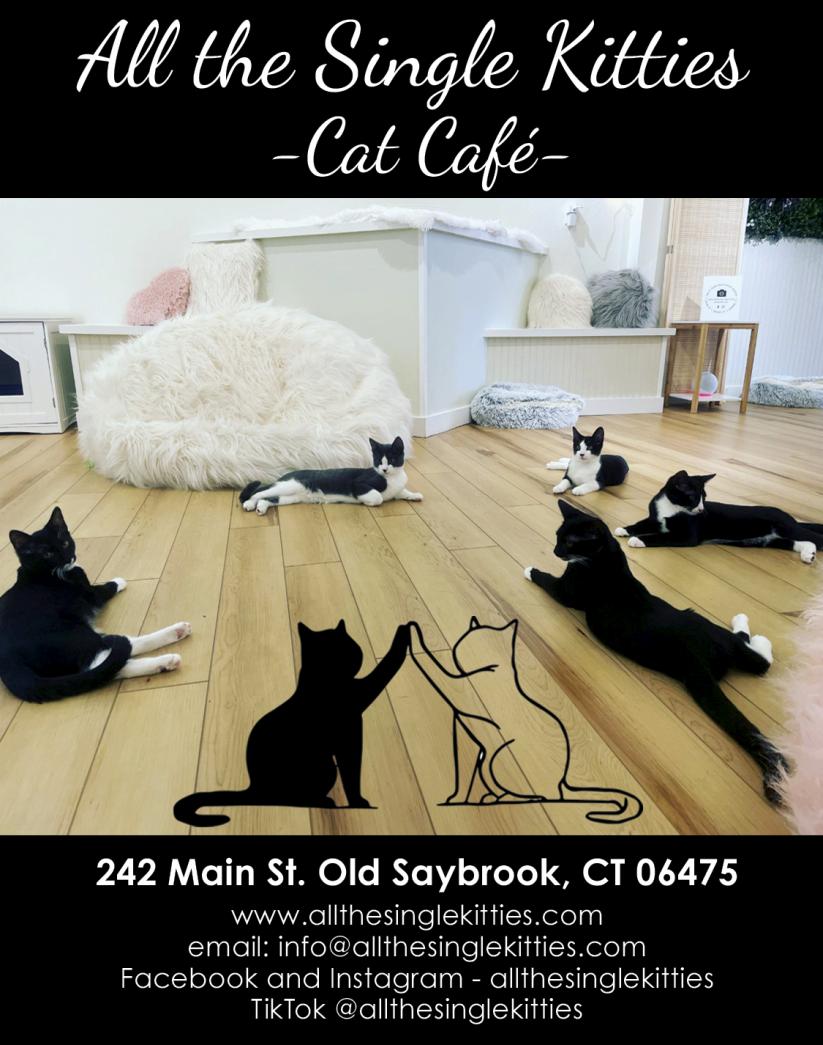

The Premier Resource t o the Connecticut Artisan 18


19 The Premier Resource t o the Connecticut Artisan
by Susan E. Cornell

20
Photo by Susan Cornell
Ground Hog Day 1993

“This is one time where television really fails to capture the true excitement of a large squirrel predicting the weather.”
21
Phil
Connors,
ell, it’s Groundhog Day... again. Seems like déjà vu all over again since, well, it’s Groundhog Day …again.
In Essex, known for historic charm and an old New England Main Street, it seems there’s a parade for every occasion. There’s even a Losers Day Parade commemorating the night in 1814 when the British set ablaze all the ships in Essex Harbor.

But in February, when many of us feel exactly the way Phil the Weatherman (Bill Murray) puts it in the movie Groundhog Day, “It’s gonna be cold, it’s gonna be grey and it’s going to last you for the rest of your lives!”, Essex offers an antidote: the annual Groundhog Day Parade, a tradition dating back to the late 1970s.
But the festivities are completely unlike Phil’s depiction: “This is pitiful. A thousand people freezing their butts off waiting to worship a rat. What a hype.”
Instead, parade-goers worship Essex Ed, a supersized groundhog dressed in a surprise disguise each year. He (or she when Essex Edna) is escorted from Essex Boat Works on Ferry Street up to the top of Main Street by hundreds of fans (some dressed in their finest groundhog gear) who wildly use whatever it takes – pots and pans with lids, whistles, spoons, trumpets – to make enough of a racket to “wake up” the pseudo-rodent.
Marchers are accompanied by fire engines, antique cars, and fife ‘n drum corps as Ed makes his way to rest at the traffic circle where North Main meets South Main and is then placed over the “silent policeman” (the lighted traffic marker at the intersection). The Griswold Inn serves popcorn and hot chocolate, just as it has done since the first celebration. This is quite a sight, fun for all ages, and a must-experience at least once.

Essex Ed turns 45 this year. Over the years, he has sported a wide range of disguises, ranging from an Olympic skier, complete with a gold medal touting “Gopher the Gold”, to Superhog, with a cape and Superwoman-style uniform. He/ she’s been the Captain of the Titanic, Princess Leia, a football player, firefighter, fisherman, soldier, Beethoven, preppie, librarian, and even Elvis in honor of The King’s 75th. Every year, a community organization dresses Ed in a costume honoring an individual, a group, or a special occasion. The costume and organization remain top secret until the big day. The Essex, CT festivities aren’t nearly as famous as those in Punxsutawney, PA but they certainly are celebrated with at least as much spirit and enthusiasm, and that’s what you’d expect from a town that just love its parades.
But why do we celebrate the day at all? I was curious. Many customs of Groundhog Day come from Candlemas. The event, as we know it with the groundhog’s shadow (or lack of) serving as a soothsayer of impending weather, dates back to the 1800s, and seems to have been a German custom from Pennsylvania.
22
Above: Photo Courtesy of Susan Dee, President, Essex Board of Trade Bottom: Photo by Susan Cornell
An early American reference to Groundhog Day can be found in a diary entry, dated February 5, 1841, of Berks County, Pennsylvania storekeeper James Morris: “Last Tuesday, the 2nd, was Candlemas day, the day on which, according to the Germans, the Groundhog peeps out of his winter quarters and if he sees his shadow he pops back for another six weeks nap, but if the day be cloudy, he remains out, as the weather is to be moderate.”
Biologists who study groundhogs, however, say the animal is probing conditions for, ummm, more personal reasons. That is, males are scouting out where female burrows are because it’s been quite a while since they last mated. After checking out their territory, the boy groundhogs return to its burrow to sleep for a few more weeks, and then emerges for a busy week that will lead to an April baby boom.
The Essex Ed tradition was dreamed up in 1978 by a local resident who “decided to inject some fun into an extremely cold and unpleasant winter.” The result, Ed, was referred to as “creative vandalism—a way to get everybody outside for some silly, winter fun.”


In the old days (aka the late 1970s and 1980s), The Griswold Inn would hold the Annual Feast of the Groundhog (n.b. the groundhog was celebrated, not feasted upon). “The Gris” menu reflected the cultured traditions of the Pennsylvania Dutch and delicacies such as baked Oysters Allegheny, Stuffed Pork Punxsutawney, and Shoo-fly pie. The celebrations didn’t end there. According to an article in The Gazette, there was a dance, “songs and silliness.” Essex Ed was a special guest and enjoyed songs which included “Glory, Glory to the Groundhog.”
 From Wikipedia —
From Wikipedia —
“We pull it out and put it in our shop where it's nice and warm so people can dress it and then the town crew comes and picks it up for placement on Groundhog Day.”
23
Photos of various newspaper clippings collected Courtesy of Essex Historical Society Below: 2020 - Board of Trade
Tumbledowns Cafe, now known as The Black Seal, would hold contests for best and worst drinks. You can guess in which category one called “Foaming Chunks,” consisting of beer and heaping tablespoons of peanut butter mixed in a blender until “frothy foam appears” belongs.
Life hasn’t been all sunshine and rainbows for the monstrous marmot mascot.
There was the year 1985 when, for the first time in his/her eight-year history, the critter missed the coming out party; Ed had suffered from several small puncture wounds mysteriously inflicted during hibernation at the local marina.
Then, in 1993, “nearly 36 hours after Ed led a parade of more than 1,000 people in biting wind and snow through Essex Village, vandals destroyed the popular rodent, torching its flammable structure,” read the front page of the Pictorial Gazette (February 6, 1993). That year the character was, ironically, a firefighter.
It took a year of fundraising and rebuilding, but a new fiberglass – and fire retardant – model of the seer of the seasons was born. This is the Ed we know and love today.
Ed spends most of the year in the back of a warehouse in town. Not to give any clues as to the location, but Essex resident Herb Clark of the Clark Group says, “We’re certainly glad to help out with this great event. It’s been interesting and fun over the years.” Rumor around town has it, however, that Clark’s employees refer to Ed as “The Rat.”
A few weeks before the coming out, Clark explains, “We pull it out and put it in our shop where it’s nice and warm so people can dress it and then the town crew comes and picks it up for placement on Groundhog Day.”
Although different sources list different heights (some say 12 feet!), Clark’s crew says Ed measures 8’6”. Then, there’s the 15inch stand on which he is placed.
And, no, Clark the caretaker could offer no hints as to this year’s costume.
The Essex Board of Trade sponsors the annual parade. According to Board President Susan Dee, “What started as a humble experience to relieve winter boredom has now become a highlyanticipated tradition to celebrate not only Groundhog Day, but Essex Ed himself, who has achieved his own celebrity status.”
The local celebrity groundhog is featured in a newly published children’s book, Essex Ed’s Groundhog Day Parade, which tells the story of Essex Ed, who loves holidays and parades but misses his favorite one, Halloween, because of hibernation. Every year, Ed dresses

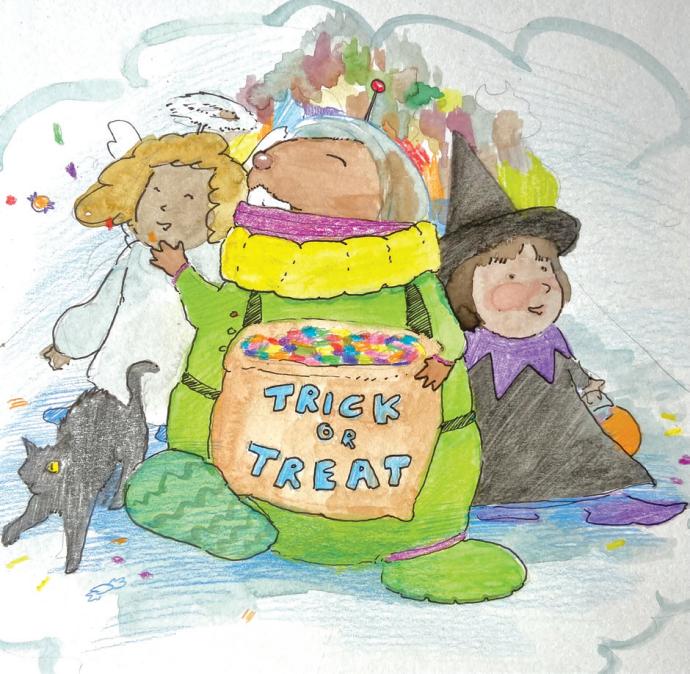


 Above: Illustrations by Mina Hamanoto Motashamam for childrens book Essex Ed’s Groundhog Day Parade written by Susan Cornell.
Above: Illustrations by Mina Hamanoto Motashamam for childrens book Essex Ed’s Groundhog Day Parade written by Susan Cornell.
24
up in fun, new costumes but falls asleep in late October, as most groundhogs do, and snoozes through Halloween. While in real life, Essex Ed doesn’t dress himself in new outfits, the illustrations in the book are of actual disguises the real Ed has worn over the years. And, unlike the true history, there is no vandalism or arson; this is a children’s book after all.
This book was beautifully illustrated an instructor at the Lyme Academy of Fine Arts, artist Mina Hamamoto Mohtasham. Mohtasham received her BFA from the Pennsylvania Academy of the Fine Arts in 2021 and has received numerous awards and honors. Ed’s book is adorable, positive, upbeat, encouraging and available on Amazon.com as well as various establishments in Essex including the Connecticut River Museum, The Griswold Inn Store - Goods & Curiosities, and Toys Ahoy!, and in Old Lyme at de Gerenday’s (Lyme Academy of Fine Arts).
This year, if you revisit the movie “Groundhog Day” which was released 30 years ago this February and is one of the best romantic comedies ever, you’ll be reminded of a positive and encouraging perspective. And bring your noisemakers and spirit to Essex for the Groundhog Day Parade. As Phil says, “This is one time where television really fails to capture the true excitement of a large squirrel predicting the weather.”
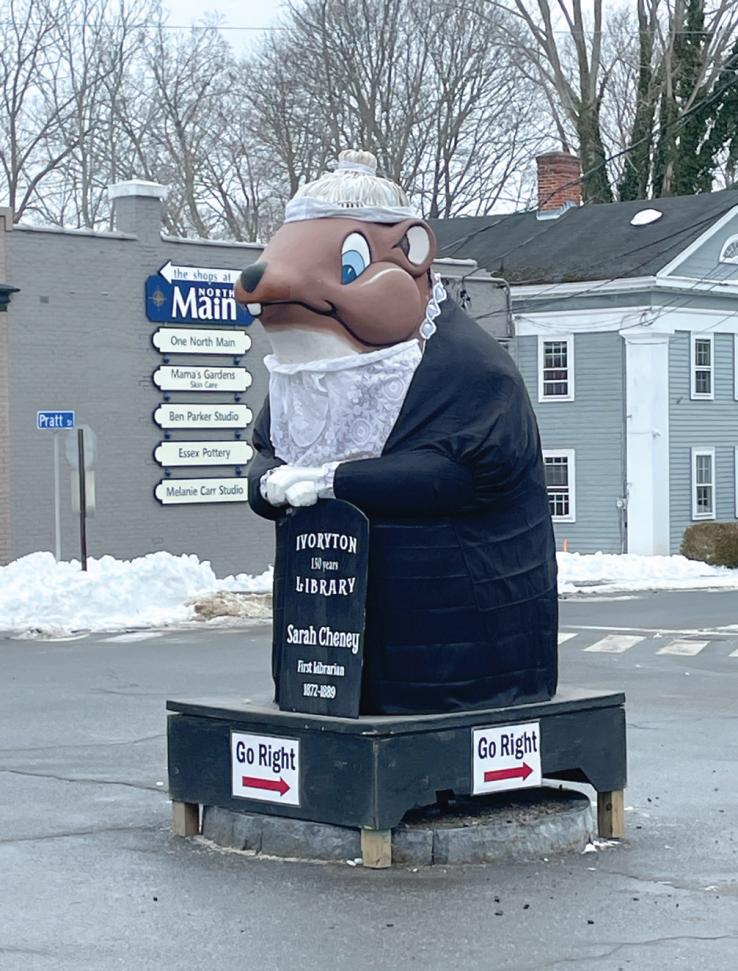

“What started as a humble experience to relieve winter boredom has now become a highly-anticipated tradition to celebrate not only Groundhog Day, but Essex Ed himself, who has achieved his own celebrity status.”
25
Above:
Essex Historical Society. Below: Image Courtesy of Shore Publishing Publishing





The Premier Resource t o the Connecticut Artisan Virtual Gallery Exhibit VALENTINE H. ZAHN COMMUNITY GALLERY THE GALLERY AT MIDDLESEX HEALTH SHORELINE MEDICAL CENTER 250 Flat Rock Place, Westbrook, CT 06498 860-358-6200 + info@midhosp.org + MiddlesexHealth.org Sue Mullaney, Swallowtail, mixed media, acrylic and analo collage (detail) November 1, 2022 - January 28, 2023 Visit the gallery from the comfort of your own home at MiddlesexHealth.org/TCC “Mixing It Up!” A group exhibition featuring selected works by members of the The Creative Collective Sponsored by 26




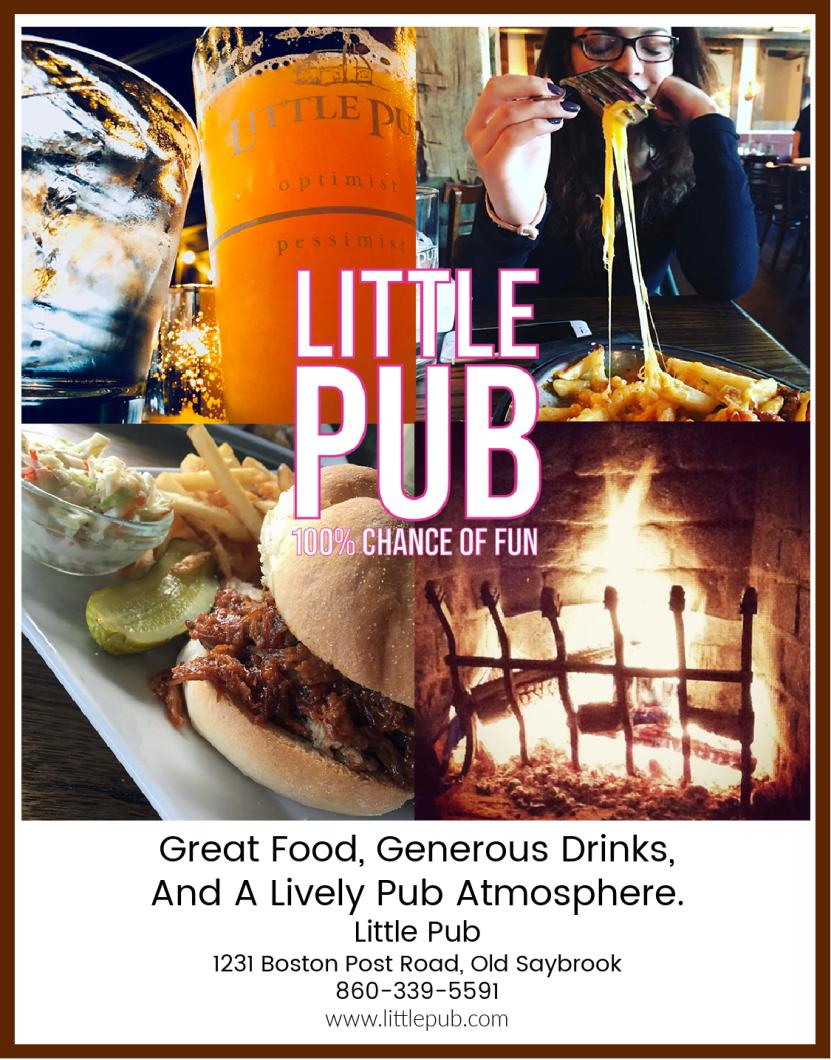
27 The Premier Resource t o the Connecticut Artisan
AskAshley Ask
New Year, Better You
By Ashley Alt
How to embrace Slow Living in 2023
2023, it’s nice to meet you. Time seems to pass quicker and quicker as we get older, which motivates me to keep exploring life and all of the people and experiences that make it wonderful.
Speaking of wonderful, there’s no better time than the present to start thinking about who we want to be this year, including how we want to live and what changes need to be made in order for us to carry out our most fulfilled lives.
On the health front, Digital Wellness is going to be big this year. Everyone from entrepreneurs and life coaches to wellness experts and podcasters have been opening up about their technology burnout struggles, including iPhone addiction (an actual thing) and screen-time fatigue.
What is Digital Wellness, you ask? To be “digitally well” is to pursue an intentional and healthy relationship with technology, both in the workplace and in our personal lives. Digital Wellness is about taking control of your life considering all things digital, from watching less TV to limiting doom scrolling and overall screen time — using your devices only when necessary instead of relying on them as a boredom crutch.
Slow Living For The Win
Digital Wellness feeds into a bigger concept that was touched upon in years prior, better known as Slow Living, a lifestyle that encourages a slower approach to aspects of everyday life, involving completing tasks at a leisurely pace.

28
My interpretation of Slow Living lies somewhere between hustle culture and laziness. The idea is to obviously slow down, but what’s more important is the mindfulness aspect of Slow Living, including making decisions based on what our gut is telling us instead of what we think is expected of us, and living fully in the present moment (without our phones). It’s about leading a life with intentionality instead of checking off our to-do lists and calling it a day.
According to Dr. Jenelle Kim, author of Myung Sung: The Korean Art of Living Meditation, “Slow Living is a conscious approach to life that involves living slower so you can appreciate each moment and prioritize what matters in life.”
This concept applies excellently to New Year’s resolutions. When we set goals that are too big to swallow, we never follow through. However, if we set smaller, more attainable goals, the chances of seeing them out are far greater.
Benefits of Slow Living
As you now know, Slow Living is rooted in mindfulness; being in the present moment.
Mindful consumption = better brain health, including improved energy and greater levels of satisfaction. This applies to everything we consume on a daily basis, from the food we eat and TV shows we watch to the people we interact with online and in-person.
Goal Setting by Slow Living
Given we are in the month notorious for unrealistic goal-setting, I thought it would be beneficial to round up some manageable goals that don’t feel like chores.
Because let’s be blunt. The empty promise of “I’m going to start going to the gym” is tired. And it never works. In order for actual change to happen — whether it’s in our bodies, careers, home life, or relationships — we need to be specific on what we want to achieve and why.
For this reason, I’m a big fan of setting small, attainable goals throughout the year instead of one looming goal that feels impossible to accomplish.
For example, if better fitness is what you’re after, start with a small goal you know you can reach instead of vaguely stating you’re going to start hitting the gym come January. Maybe you want to introduce strength training into your workouts. Instead of setting the goal as, “I’m going to start lifting weights,” get specific. Turn “I’m going to start lifting weights” into “I’m going to lift 3-lb weights during my lunch break every day this week.”
This year, in the name of Slow Living, I’m dedicating each month to its own digital wellness goal.
A mindfulness coach I spoke with on this topic compares her Instagram page to her home, stating if she wouldn’t invite them to her actual house, there is no room for them on her Instagram feed. Her point: To only follow accounts that make you feel good, explaining if you wouldn’t invite 300 strangers into your home when you wake up (before you brush your teeth and comb your hair), why would you start scrolling through social media the second you hop out of bed?
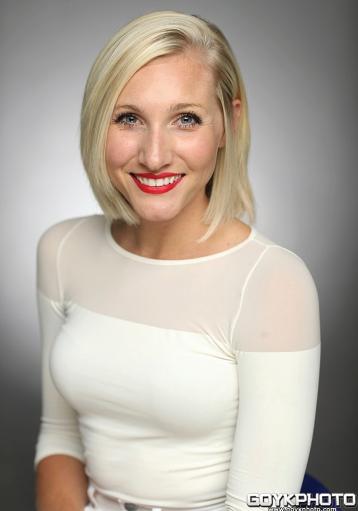
The same notion applies to eating meals. When we eat mindfully, we eat slower, and are th–erefore more conscious of what we are putting in our bodies. This prevents overeating and the consequences associated with it including discomfort, unwanted weight gain, and feeling low-energy and sluggish.
My goal for January is to only reach for my phone when I need to — as I know mindlessly scrolling depletes my energy (not to mention makes me feel bad about myself). In order to keep this top of mind, I’m going to write down “Less screen time, More free time” every morning when I wake up. Once February rolls around, I’ll implement another small goal. The idea is to stack one small goal on top of one another, so by the end of the year, you will have accomplished not one, but 12 goals, all in the pursuit of wellness and fulfillment.
Happy New Year and good luck on your Slow Living goals!

To keep up with Ashley, follow her on IG @ashleyalt_ and sign up for her newsletter: https://ashleyalt.substack.com/.

29






























































The Premier Resource t o the Connecticut Artisan P ) N R E T WES ( E T N E OM W T UO Q E T E K C TU : T C E J O R P S – R 8 E B O T C O e r u t a n y r a or p m te con h t o nb ni e m o tw o u q e P e h ft eo d u t i t r tfo n e i l i s e r t a n i m r te e d d te
tW o u q
eP
.T
r b
sav
p x l e ra u t l u s c u
I 7 Y2 A M d n la a n o i t i d ra at n) r te s We t ( ke c u t n a h s a eM d n r a te c ra a h t c n ra b i , v n o i s e i f i l p m e x ne o i t i b i h x ne e m Wo d n y a t i u q i t n fa y o r to ts
n d o veye n o n c e h , w n o i s s e r ORE OR M F T SI VI S , L AI DET Q . M 06338 T , C C KE T L A I T R T U O 6.6 9 1 0 9 3 G OR M. USEU 31
i r i p e s h t
e
h
e c n e i l i s e r
i
t n e s e r , p s a v n a c
o n e g i d n
n a

32
Profile by Laurencia Ciprus Photos Courtesy of Patrica Kelly
August pre-Covid ... the first edge-of-the-seat conversation on the grounds of Ebony Horsewomen Equestrian and Therapeutic Center with founder, Mrs. Patricia Kelly, who has shepherded the equestrian and youth focused non-profit for over the past 30+ years. Yes...everyone calls her Mrs. Kelly in deference to her tireless community efforts that has placed the organization on the map while personally garnering Kelly a 2014 CNN Hero’s Award, induction into Houston’s Cowgirl Hall of Fame, and an appearance on the Queen Latifah Show.
The campus for EHI – part of Hartford’s historic 633-acre Keney Park, designed by architect Frederick Law Olmsted ¬-– was originally established for African-American female equestrians in Hartford’s North End. Mrs. Kelly took notice of the struggles of young people slipping through the cracks unnoticed –many whose parents and extended families were constantly challenged to keep them safe, housed, fed, and educated. EHI offered them unique experiences, structure, education, and a safe haven in ample green space. Kelly observed that far too many inner-city youths never dare to dream about their futures. Kelly needed to intervene with solutions. “These urban kids are exposed to experiences that are impossible to process as adults, let alone with the mind of a child.” Kelly continues without hesitation, “These kids need direction, guidance, and

33
“These kids need direction, guidance, and discipline... it seems that they are so anxious, that they just don’t have the normal fun that comes with the joy of a real childhood. How can they imagine possibilities when they are conditioned not expect to live past 21.”
discipline...it seems that they are so anxious, that they just don’t have the normal fun that comes with the joy of a real childhood. How can they imagine possibilities when they are conditioned not expect to live past 21.” Pat Kelly’s mission proved successful.
“At Ebony Horsewomen, we show them a different and transformative way to live while providing them structure. Electronics are checked at the door, and there are expectations to live up to when they come here. Seeing them connect with horses is something to witness. It transforms their level of confidence, raises self-esteem, and just being here provides an additional a sense of family and belonging... and of course, of possibility.” She smiles. “So many come of my older kids come back to visit, act as mentors, and give us their time.” News of Patricia Kelly’s proven formula for success and empowerment has spread beyond the North End Hartford Community. Outside human services agencies regularly send their most at-risk children to Ebony Horsewomen for animal and equine assisted therapy which is a proven modality. Clients maintain their anonymity while in therapy; allowing them to heal while mainstreamed along with the other kids without any sense of shame or stigma.
The established programs at EHI have expanded over the years. Ebony Horsewomen trains Junior Mounted Patrol riders who keep watch over the 633 acres of Keney Park on horseback; surveying the entire landscape – including the golf course and walking trails for any unexpected issues. Other riders evolve into highly skilled




34
equestrians – competing in horse shows and rodeos and expansive experiences normally beyond the reach of the urban norm. Part of the experience at EHI is service. Participants maintain the property, tend to the horses and small animals, and perform acts of service in a multitude of roles. The demographic has also expanded: suburban kids and adults

Fisher, a kindly neighbor with his long white beard really started things. To a little girl like me, he looked like Santa Claus...he still drove a horse and buggy to deliver groceries. We had recently moved into our home on Clark St, and I was new to the neighborhood.” She smiles...”Mr. Fisher became my friend and my mentor. He introduced me to his horse; taught
have discovered Ebony Horsewomen and are frequent visitors to the EHI at Keney Park; joining neighborhood regulars for lessons, special events, and familiarizing themselves with horses.
Gears shift back to beginnings. Mrs. Kelly reflects, “How did my personal connection with horses start? Eyes moving...always mindful of the horses and students moving around her, Kelly relaxes, leaning back into childhood and some origin stories. “...Mr.
me how to tack up and taught me to ride. I credit him for introducing me to the equine world, and my love for horses and riding has never stopped.”
There were detours and discoveries informing Mrs. Kelly’s path to the institution Ebony Horsewomen has grown into today. There was her service as a Marine during the Viet Nam War; then taking advantage of the GI Bill to attend Law School and working in the community for 16 years with Neighborhood
35
Legal Aid. She returned to riding in 1984 – gathering a group of friends to join her and established the beginnings of Ebony Horsewomen. Family history equally influenced the journey. When she was 30, Patricia discovered that her father had been a jockey – something he never spoke of. His career ended abruptly after surviving a horrific riding accident. Her father showed an aversion to horses and even tried to discourage his daughter away from the sport.

This family knowledge piqued her curiosity about equestrian culture, and she began unpacking the history of AfricanAmerican contributions to the foundations of the sport. There was a wealth of information unearthed. Kelly becomes animated. “Did you know that the first thirteen winning jockeys of the Kentucky Derby were Black men? When Kentucky changed the rules and banned them from competing, many went on to join overseas equestrian teams and continued to capture wins.” Mrs. Kelly grows serious. “These contributions and so many others were made. There were and still are Black ranchers, jockeys, trainers, grooms, breeders, competitors and so much more. This history has been hidden, dismissed, denied, and erased from history.”
We reconnect post Covid. It is late 2022 – picking up the deep conversation in Patricia Kelly’s executive office...the walls illustrating an ongoing story still being written. They are lined with equine ephemera, ribbons, and photographs... countless awards and commendations. There is tack hanging from the walls, and a heavily tooled Western leather saddle on display. This is the chill and cozy –yet impeccably run – nerve center of the operation. She takes a call and continues. “It is time to acknowledge and celebrate African American equestrians and we’re going to do to realize this vision.”
On Sunday evening January 9th, 2023, Patricia Kelly and Ebony Horsewomen host the first “Black Boots Awards” in Hartford CT celebrating and recognizing the contrinutions of African-American members of the Equestrian Industry from across the US. Emceed by Marvin Pittman of NBC Sports, the event runs live and virtually by SteamHorse TV in collaboration with Black Reins Magazine.


The event evolved in collaboration with Jeffrey Fletcher, a former New Haven, CT Mounted Police Officer and owner and President of The Calvin Fletcher African American History Museum in

36
Stratford, CT With a myriad of categories celebrated, nominees run the gamut: from Western and English riders, Clubs and Organizations, all categories of Rodeos, Tradesmen, Museums and Equestrian Influencers.

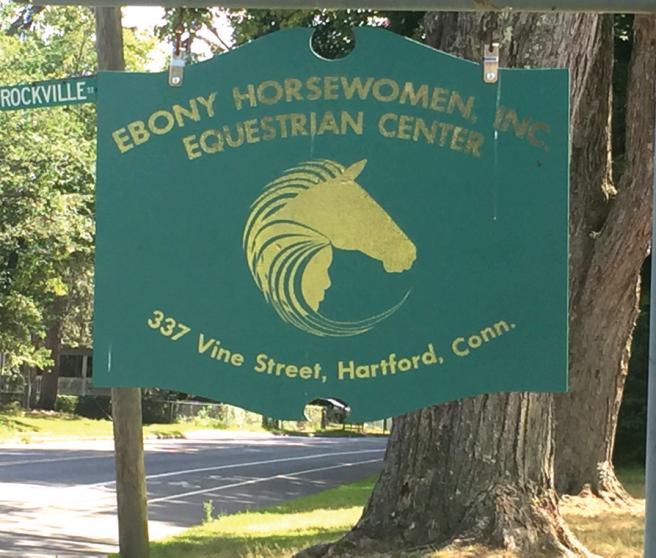
The organization continues to grow and flourish, while keeping the original foundation in place and a steady finger on the pulse points of the North End Hartford Community. In May of 2022, Ebony Horsewomen recognized eight women who have supported the community with their service, kindness, and advocacy. The Heroines of Hartford event also marked the unveiling of a series of portraits of the honorees painted by esteemed fine artist Levi Robinson of DC.
There are new milestones slated for 2023 for EHI, beginning with the construction and completion of the Mary Fields Museum and Training Space. This expansion will be facilitated through a grant from the State of Connecticut Department of Economic and Community Development (DECD) This realizes a long-term vision to establish the first dedicated museum in Northeast Hartford. Consciously designed to keep in harmony with the rest of the park, the Mary Fields Museum and Training Space commemorates the history of African Americans during pioneer days with both virtual and hands on exhibitions. The facility also adds additional classrooms, training and meeting spaces and banquet space for Ebony Horsewomen to accommodate new programming. Mary Fields – aka Stagecoach Mary – (1832-1914) proves the ideal honoree for the museum. Born a slave, Mary was the first female African-American Star Route US Postal Service mail carrier and a remarkable example of fearlessness during this period of expansion in the US. Mary was singular in her dedication to service to the nation and highly respected by the men of her time as both a peer and a legendary figure shaping history.
Like Mary Fields, Patricia Kelly continues to innovate and persevere though EHI...continually reaffirming herself as an activist, icon and champion on horseback.

For further information about Ebony Horsewomen: https://ebonyhorsewomen.org/
Stagecoach Mary, or Mary Fields submitted her application in 1895 to work as a postal carrier for the United States Postal Service in the Montana Territory. Mary and a dozen cowboys her age were ordered to hook a team of six horses to a stagecoach during the interview. After tying up her horses and making her way to the saloon for a shot, 60-year-old Mary fired up a cigar and laughed as the other cowboys finished. Mary was hired. She was just the second woman and the first African-American to be given a contract to carry mail. Photos
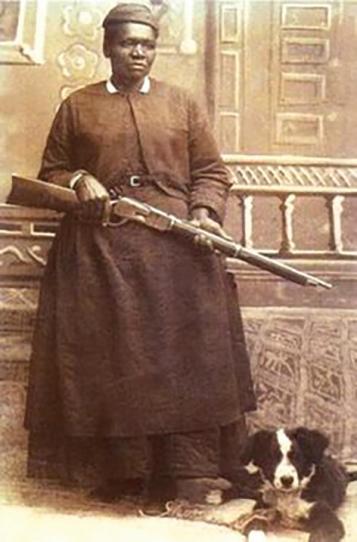
Above: Mary can be seen operating a carriage with her horse, Moses. Mary with a 10 gauge shot gun and her Dog. Mary retired after 8 years and pick up babysitting for extra change and one of the children she babysat was Gary Cooper who lived in Dearborn Montana. In 1959 Gary Cooper wrote a fond remembrance of Mary that was published in Ebony magazine.

37



The Premier Resource t o the Connecticut Artisan 36

39
40




41
atthew Barnes’ passion for nautical is tattooed into his forearm with the latitude and longitude of his home port, Stony Creek, at Connecticut’s Thimble Islands. A wooden boat builder, Barnes has been a woodworker for most of his life. In the summer of 2016, he had the opportunity to apprentice at the Viking Ship Museum in Denmark and travel around Scandinavia. During this time, he fell in love with the people, culture, craftsmanship, and work ethic of the region. Now, he’s brought his skills and passion home where he has built a Viking ship replica from scratch and all by hand.
“One of my favorite things about this Gislinge project is the fact that almost nothing we are using can be bought off the shelf. Aside from our axes and hammers, we have made everything from scratch,” Barnes explains.
Barnes worked for some of the biggest names in the boat building and ship restoration industry before forming Leetes Island Boatworks. He was lead shipwright of the restoration of the Mayflower II at Mystic Seaport and lead carpenter at the Service Yard at Morris Yachts.
Barnes teaches and lectures on traditional Viking shipbuilding techniques. When he’s not building boats, teaching or lecturing, he’s creating furniture, custom woodworking, and buildouts through his other company, Håndlavet, which translates to “handmade” in Danish.
The 38-year-old has been in the marine trades for over 25 years. At 11, Barnes started working on the Thimble Islands tour boat, Sea Mist. He spent every summer aboard Sea Mist for almost 10 years. After high school, it was pretty clear that college was not the right path so he spent the next five or six years traveling and working, primarily working for a small boatyard in Westbrook.
At 25, Barnes enrolled at the International Yacht Restoration School (IYRS), a two-year trade school in Newport, RI that teaches traditional wooden boat building and restoration. After graduating from IYRS, he spent a year and a half up on Mount Desert Island working for Morris Yachts then came back to Connecticut and worked for himself for a while. Eventually, Barnes ended up at the Mystic Seaport Museum. He was hired for six months to help finish the Charles W. Morgan restoration, which led to him working there for almost eight years.
“The Museum is where I really learned about and fell in love with traditional shipbuilding; apprenticing under the master shipwrights who worked there was an education that I really couldn’t get anywhere else,” Barnes says and adds, “Now I co-own Leetes Island Boatworks based in Guilford and Stony Creek with

42
my partner, Tucker Yaro, where we specialize in wooden boat building, restoration, and maintenance.
When asked why one would build a replica of a 12th-century Scandinavian vessel he laughs, “Why not?” Truthfully, the ship was commissioned by a Virginia non-profit that focuses on veteran outreach. This group of Viking enthusiasts requested this unique vessel but did not ask that it be built by scratch and by hand.

The 5 ½ -feet-wide, 26-feet-long vessel comes with a price tag of $70,000: expensive, but the nonprofit is not paying for the additional efforts. She holds three to five passengers with three spots for sailing and rowing on the Chesapeake River.
This was an opportunity for Barnes, and it was something he wanted to do because he loves this type of work. The ax is the main tool.
“During the Viking Age, this was the primary tool for ship and boat construction. With no real access to saws for milling timber, the planks are cleaved out of whole logs. This is the process of driving wedges down the length of the log and splitting the log into 16 pieces. These would then be hewn down to a 20 mm thick, flat plank.”
“The process of cleaving a plank makes the strongest and most flexible piece of lumber you could find. It allows the lumber to split along its natural grain keeping all the long grain or ‘lignin’ intact. Lignin is essentially the muscles within the tree, all the other structural parts of the ship (e.g., floors and knees) were hewn from natural growths or a crook in the tree. All almost 100 percent done with an ax.”
Other tools used were bow drills, scrapers, crude forms of small planes, and simple chisels. A variety of hammers for riveting the ship together were also used.
“Ships were riveted with a type of iron called “bog iron” which was commonly used in Viking age Scandinavia. The spars were mainly made of clear fir or oak, and the sails were made of flax and later rumored to be made of silk. Rope and line were made of horsehair and other natural fibers. Caulking was made of tarred lanolin wool (the traditional form of caulking for a Viking ship, made from lamb’s wool).”
For this build, slightly more modern materials are being used. “We are using copper rivets instead of iron, tarred oakum for caulking, and our rigging will be made of Vintage 3-Strand line (a modern rope provided by New England Ropes. It looks very similar to a traditional line but is much stronger and lighter).” This is all to improve performance, safety, and longevity of the

43
boat. But the building methods are close to what was done in the Viking Age.
The process of building a Viking ship replica here in the Northeast is somewhat like that in the days of the Vikings. Barnes explains, “The tradition of the skill and craftsmanship are the same, and a lot of the methods are the same. The principles of shaping a timber by hand for the Charles W. Morgan and the Mayflower are the same as the Gislinge.* It all starts with a log, and then there are a series of steps to achieve your goal.” Eighteenth and nineteenth-century ship builders relied more heavily on the adz and less on the ax for shaping and also had saws and mills for lumber, but mostly, the skills are the same. (An adz is an edge tool used in shipbuilding and timber framing. It’s essentially a large chisel with lipped sides on a curved handle, kind of like a garden hoe in looks but made for woodworking).


One main issue which surfaced early in the project was acquiring the timber for the project. “In Denmark, they have an incredible source of oak in forests specifically grown for shipbuilding. Not so much here. Trying to find a log a meter wide and seven meters long was quite a task. Luckily, we have a great supplier who worked directly with loggers to find us some beautiful material,” he said.
* The Gislinge Boat was a 7.7m long working boat, most likely used for fishing and the transport of people, livestock, and goods around the coastal settlements of the Lammefjord. It was uncovered in 1993 during drainage works north of the village

44
of Gislinge, on the island of Sjælland in Denmark. The boat has been dated back to 1130 A.D.
The boat will launch right off where she was built, at Bradley & Waters Marine Railway in Stony Creek. The launch was scheduled for October but, when Barnes broke his hand in September, this delayed things a bit. Understandable, as “handmade” is rather challenging with a broken hand. “Surrounded by the Thimble Islands, you couldn’t ask for a better place to build and restore boats,” he says.
Apprenticing at the Viking Ship Museum in Denmark was like no other experience. At the time, Barnes was working for the Mystic Seaport Museum and was fortunate enough to have been awarded the Mallory Fellow Ship Grant, which is given by the Museum to one of its employees to travel and work with another foreign museum or institution.
“While I was there, I worked and lived with the boat builders being fully immersed in the job and the history. They are the kindest people, taking me right in despite not speaking the language. Their passion for the craft and history was inspiring; the Danes take a lot of pride in their work, and I couldn’t help but feel part of it.”
Barnes is neither Danish nor a known Viking descendant. His ancestors were mainly from Britain and Germany “so probably at some point, but no real known connection,” he says and adds, “I just really like their style.”And that he does, as evidenced in furniture, custom woodworking and buildouts created at Håndlavet, in Madison.

Restoring and building boats is similar to creating handmade furniture, except “furniture is profitable,” he quips. And with an estimated 2000 hours it takes to build a Viking ship, one can see that. Those 2000 hours, incidentally, “don’t count all the times I have to stop and explain exactly ‘what the hell’ we are doing,” Barnes jokes again.

In all seriousness, however, woodwork is their connection. “Milling, shaping, cutting, sanding, all this stuff goes hand-inhand, with the main differences being that boats are round, and most tables are square. Oh, and I also don’t need to make sure a table floats, I guess that’s a big one.”
“Mainly the two are most connected in a metaphysical way. We are all, by nature, trying to create and create well. Whether it’s building a beautiful boat that will physically take you somewhere or a beautiful piece of furniture that will emotionally take you somewhere, the process and the commitment are the same. The Norse people completely believed that you will only be known for what you do in this life and that what you leave behind will define how you will be remembered. It’s all just trying to create the best way we know how, and it’s all interconnected.”
If you are interested in commissioning a Gislinge boat, built in the same manner, the price would be well over $100,000. Perhaps a piece from Håndlavet might suffice.
For more information:
Leetes Island Boatworks: leetesislandboatworks.com Håndlavet: handlavetco.com. Gallery and Showroom 63 Wall Street, Madison
45
Photograph by Susan Cornell




The Premier Resource t o the Connecticut Artisan 46



47 The Premier Resource t o the Connecticut Artisan
















48
Caryn B. Davis ofile & Photography by Pr

















France — Anatole
remains unawakened.” s soul a part of one’
“Until one has loved an animal,
49
“They are not only a completely different animal, but each individual pig is completely different from the next. They’re often misunderstood, and this is why so many people return their pot belly pigs within the first year. You have to educate yourself about what you’re getting into,” she says. “They’re not push-button animals and need a lot of enrichment.”
Madonna came to Emily after she was left alone to starve in a barn in New Hampshire. (Sometimes Madonna accompanies Emily to the medical office where she works part-time which is very therapeutic for the patients. Rosie’s human mother died of Covid, and she was so depressed she would not come out of the barn for months. Glenda was rescued off the chopping block and was fed cat food which stunted her growth, so her front feet are very short, and she struggles to walk, but she’s holding her own and now mixes with the general population. Her brother was not as fortunate.
“She’s traumatized from that. She’ll never forget it. She was with him when he died. They were bonded and when pigs bond they never lose it. They grieve when one of their own dies. They actually cry and shed tears,” Emily says.
Before Emily introduces a new pig to the herd, she first must gain its trust. She does this by having the pig sleep in the house so she can bond with it and also ensure the pig is healthy before integrating it with the herd. In the pasture Emily has built a pen within a pen, so the pigs can get used to each by sight and smell. Since the pigs did not come with a swine manual, Emily has learned a lot on her own, from the pigs themselves and from two mentors who both have sanctuaries much larger than hers in other states.
She strives to educate others who are considering a pig for a pet so they can be successful, and encourages people to come by and spend a few days learning about these animals before getting one.

Willow is Emily’s thirteenth pig, but she does not live with her even though Emily supports her financially. Willow’s story is by far the saddest. Before she came to Emily, she had been beaten so badly that all four legs had been broken and she was unable to walk. And as if Willow was not suffering enough, she continued to be bred because her piglets were worth money.
Fortunately for Willow, she had Emily and a veterinary team from Cornell University interested in her case. Willow became the first pig to have a complete shoulder replacement. Her hind legs were reconstructed, and she was soon able to stand on her own and walk again.
“The paradise of my fancy is one where pigs have wings.”
50
— G.K. Chesterton, Fancies Versus Fads
“She made history and hopefully this will help other animals in the future,” says Emily who paid for the surgery out of her own pocket to the tune of sixty thousand dollars.
Willow resides at Arthur’s Acres, a swine sanctuary located closer to Cornell and founded by Emily’s mentor, Todd Friedman. Willow will stay there for the remainder of her life to ensure she can get the specialized veterinary care she will need.



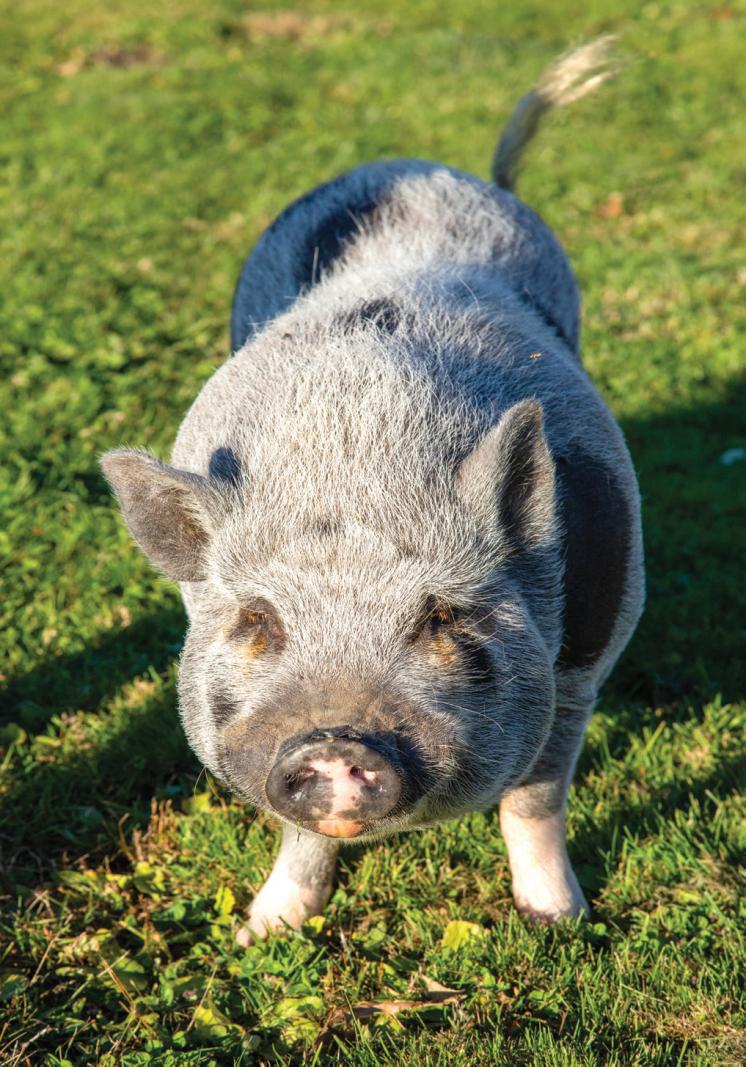
“I went to visit her, and she recognized me right away. I miss her so much, but I’d be selfish to bring her back here. But she is still my pig, and I will still pay her vet bills,” Emily says.
Unfortunately, Emily is at maximum capacity, plus it’s just her doing this so she has to say “no” all the time to new pigs. Still, she does whatever is in her power to help, whether it’s providing transportation, offering temporary shelter to a pig en route to another farm, or providing food.
51
“You have been my friend. That in itself is a tremendous thing.”





52
“The cruelty in the animal world is just awful. I go to bed crying a lot of times if I’m looking online, and there’s a pig here in dire need. It’s heartbreaking,” she says. “But I absolutely love them. They bring a feeling of fullness to my life, and when I can help an animal in need and transform their lives, I feel like I’m making a teeny bit of a difference in a world that is just not always so nice. I’m the lucky one.”

To learn more or make a much-needed donation, log onto www.facebook.com/Wherepigsfly10.



53
“I am fond of pigs. Dogs look up to us. Cats look down on us. Pigs treat us as equals.”











The Premier Resource t o the Connecticut Artisan 55
The Cheesemonger
By Paul Partica, The Cheese Shop of Centerbrook

I Forgot the Name of the Cheese
I
t hought I would start the New Year off with a little help to all retailing Cheese Mongers. Considering the known number of cheeses now topping 12,000, it’s difficult to reply to a customer’s needs when they ask for a cheese that’s “round and yellow and good.” I then usually thank them for narrowing it down to a couple thousand cheeses (wink) and ask if they can describe the cheese a little further. Below are a few considerations that can help make easier work of finding a cheese:
Source
Knowing the country of origin, if domestic, the state, and maybe the name of the maker can quickly end the search.
Size
Knowing the size of the cheese can be a very helpful start. Cheese can come in a 200-pound round, like Swiss Emmenthal, or an eight ounce round, such as Brie. Mentioning the approximate thickness of a cheese can also help to narrow it down further. For example, Brie will usually be about an inch to an inch-and-a-half thick. I say “usually” because sometimes new cheeses are created with new sizes. So simply saying you are looking for a small round cheese a bout an inch thick and around half a pound can quickly aid in finding that cheese. Trying to remember the size of the whole cheese when purchased can be very helpful to your cheese monger.
Color
Th is parameter is becoming a little less helpful because of the increasing demand for natural products. Since all cheese is naturally white, when you see a colored cheese it generally means color was added. On a positive note, the usual coloring agent is Annatto, an orange-reddish color found in the crushed seeds of the Annatto tree, found in South America. Annatto adds no taste to cheese, only color.
Some of the colored cheeses still available today are:
Shropshire Blue - A blue cheese very similar to Stilton in size and shape, only with a very deep orange color
Mimolette – Napoleon’s version of Holland’s Edam balls, who wanted them to have color in order to differentiate them from Hol land’s version
Beemster XO Gouda - A very aged form of Gouda, this cheese is lactose-free and has undertones of whiskey and butterscotch
Double Gloucester - An English cheese similar to cheddar, made from milk from the Gloucester breed of cows
Cheddar - Made in various parts of the world
Rind Appearance
This can be most helpful in describing a cheese. Here are some types you might find helpful in describing rind appearance:
White Mold - The snow-like covering of the soft-ripening cheese family such as D’Affinois, Brie, Camembert and many goat cheeses
Brown-Reddish Rind - Found in the washed-rind family in cheese like Limburger, Chaumes, Pont L’Evêque. Also found in larger hard chee ses such as Appenzeller, Comte, Gruyere, Challerhocker and Morbier
Natural Rind - Cheeses such as Parmigiano Reggiano, Piave Vecchio, Emmenthal, Tomme de Savoie, Raclette, Crucolo, and Grana Padana
Waxed Rind - Many cheeses fall into this category. Goudas, Jarls berg, Moosbacher, Black Knight Tilsit, Midnight Moon, Lamb Chopper, Parrano, etc. Cheddars are also waxed, but many have a cheese wrapping before the waxing Cry-o-Vac – Another large group of cheeses with no rind other than a tight plastic wrapping. Examples would be: Creamed Havarti, Gje tost, Swedish Farmers Cheese, BellaVitano and all of the English cheeses with added fruit, such as Mango Stilton, Cranberry Wens leydale and Wensleydale with fig and honey.
Foil Cheeses - Almost all blue cheeses come wrapped in foil Liquid Container - Many cheeses are packed in liquid for preser vation and flavor, such as Feta in salt brine and goat cheese in oil
Texture
The texture of cheese can be a great help in describing. Is the cheese spreadable, creamy, crumbly, airy, grainy, dry, sticky, rich, tangy, firm, soft, hard, and so on?
Aroma
You will not soon forget the aroma of Stinking Bishop from England. I k eep it double-wrapped and in the closed-door walk-in refrigerator. It will make a limburger seem sweet and innocent. Most of your washed-rind cheeses have this pungent smell. Soft-ripening cheeses can often have a subtle smell on mushrooms. You will also find some cheeses having the following aromas: buttery, grassy, earthy, smoky and even “barnyardy”.
Flavor
Last, but not least, if you can describe the flavor, the search can come to a quick conclusion. Is the cheese sharp, sweet, pungent, lemony, nutty, or fruity? Sharp and pungent are often misconstrued. I define sharp as wellaged cheddar versus pungent being the strong taste of Limburger or Chaumes, and of course, Stinking Bishop.
Success
If you can describe the size of the cheese, its color, the type of rind, the texture, the aroma, and a little of the flavor characteristics, there’s a good chance your cheese monger can find your cheeseor maybe another cheese very similar to it.
If all else fails, cheat. Use your smart phone to take a picture of it.
Paul Partica, The Cheese Shop of Centerbrook, Centerbrook CT www.cheeseshopcenterbrook.com
57







h B eat Gr tb tW h De eat Gr ands r rook! als y ail westbrookoutlets @ -399-8656 860 ne: w y Ho inter W 65 it E Fl 314 es at W you s op m d 6p - 0am s: 1 ur | www.westbrookoutlets.com | -95 I from ho P | 06498 CT Westbrook, | lace P Rock at x


































































ONINO NT You From Our Garage to O urs TAU anton ON G TO i noauto g NINO GROUP roup.com
AN
























































































 Jeffery Lilly founder / publisher
Jeffery Lilly founder / publisher

















































 Shown above: Caryn Paradis NCIDQ, Kim Vickerman, Design Manager, Brunette-Haylee Cox, Interior Designer Not pictured, office manager, Bonnie Ludovico
Shown above: Caryn Paradis NCIDQ, Kim Vickerman, Design Manager, Brunette-Haylee Cox, Interior Designer Not pictured, office manager, Bonnie Ludovico





























































 From Wikipedia —
From Wikipedia —




 Above: Illustrations by Mina Hamanoto Motashamam for childrens book Essex Ed’s Groundhog Day Parade written by Susan Cornell.
Above: Illustrations by Mina Hamanoto Motashamam for childrens book Essex Ed’s Groundhog Day Parade written by Susan Cornell.


























































































































































































































